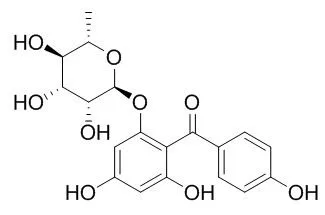| In vitro: |
| Planta Med. 2003 Aug;69(8):733-8. | | A phytochemical study of lignans in whole plants and cell suspension cultures of Anthriscus sylvestris.[Pubmed: 14531024] |
METHODS AND RESULTS:
In the roots of Anthriscus sylvestris 12 different lignans were detected. Arctigenin, Dimethylmatairesinol, dimethylthujaplicatin, podophyllotoxin, 7-hydroxyyatein and 7-hydroxyanhydropodorhizol have not been previously reported to be present in A. sylvestris. In the cell suspension cultures, which were initiated for this study, trace amounts of deoxypodophyllotoxin could be detected. With these cell suspension cultures we carried out feeding experiments using deoxypodophyllotoxin, yatein and, anhydropodorhizol.
CONCLUSIONS:
Yatein had a toxic effect on the cell cultures and was, like anhydropodorhizol, not converted into any detectable product. Deoxypodophyllotoxin, in contrast, was converted into podophyllotoxin, yielding significantly higher concentration than measured in whole plants. | | Journal of Health Science, 2011, 57 (57) :184-7. | | Identification of Dimethylmatairesinol as an Immunoglobulin E-suppressing Component of the Leaves of Cinnamomum camphora[Reference: WebLink] | Immunoglobulin E (IgE) plays an important role in allergic diseases.
METHODS AND RESULTS:
In this study, we found that a methanol extract of leaves of the camphor tree Cinnamomum camphora (C. camphora) reduced the amount of IgE secreted by human myeloma U266 cells. When the methanol extract was fractionated by extraction with organic solvents, the ethyl acetate fraction showed the highest activity. The fraction was further separated into several subfractions by preparative TLC. We identified the component of one of the active subfractions as Dimethylmatairesinol. Authentic Dimethylmatairesinol exhibited similar ac-tivity.
CONCLUSIONS:
Thus, the extract of C. camphora and its com-ponents including Dimethylmatairesinol have poten-tial as an anti-allergic agent. |
|






 Cell. 2018 Jan 11;172(1-2):249-261.e12. doi: 10.1016/j.cell.2017.12.019.IF=36.216(2019)
Cell. 2018 Jan 11;172(1-2):249-261.e12. doi: 10.1016/j.cell.2017.12.019.IF=36.216(2019) Cell Metab. 2020 Mar 3;31(3):534-548.e5. doi: 10.1016/j.cmet.2020.01.002.IF=22.415(2019)
Cell Metab. 2020 Mar 3;31(3):534-548.e5. doi: 10.1016/j.cmet.2020.01.002.IF=22.415(2019) Mol Cell. 2017 Nov 16;68(4):673-685.e6. doi: 10.1016/j.molcel.2017.10.022.IF=14.548(2019)
Mol Cell. 2017 Nov 16;68(4):673-685.e6. doi: 10.1016/j.molcel.2017.10.022.IF=14.548(2019)